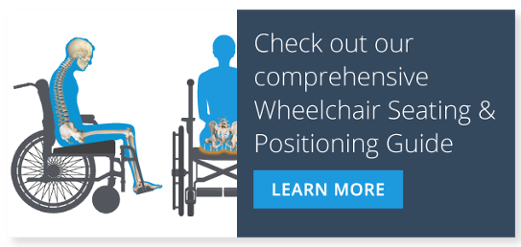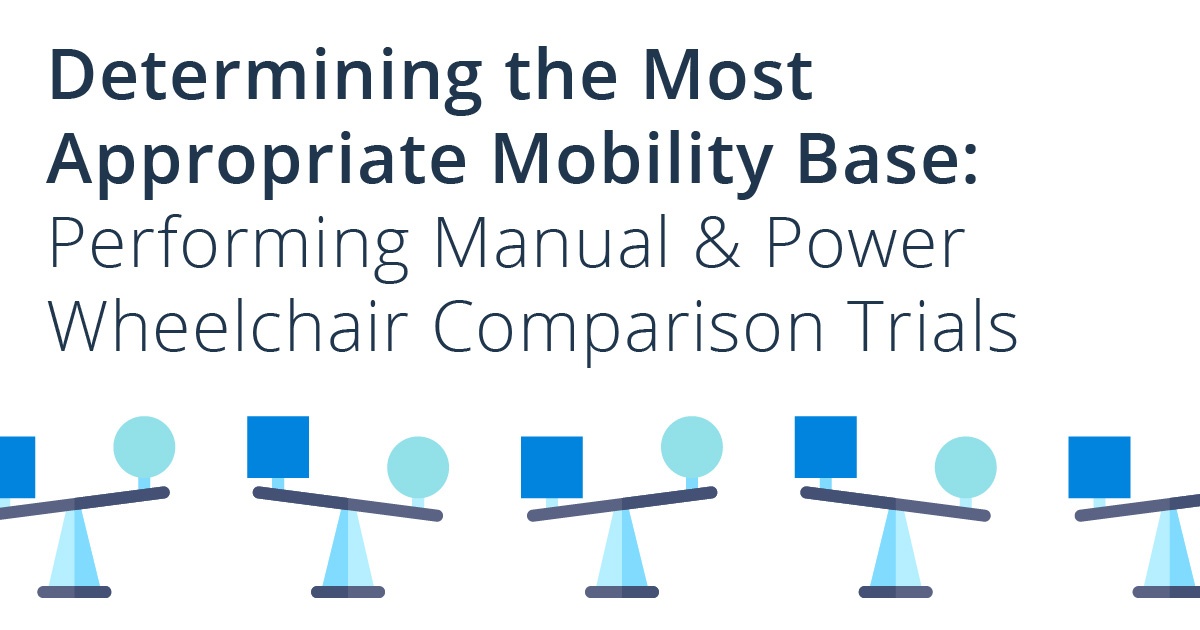Part 13 in our series A to Z Considerations for Seating & Wheeled Mobility: A Quick Reference Clarifying Confusion Around CRT. See Part 1, Part 2, Part 3, Part 4, Part 5, Part 6, Part 7, Part 8, Part 9, Part 10, Part 11, Part 12, Part 13, Part 14, Part 15, Part 16, Part 17, Part 18, and Part 19.
To determine if a power wheelchair versus a manual wheelchair is the appropriate mobility base to allow your client the ability to complete MRADLs and all necessary functional tasks as independently as possible, then completing comparison trials is recommended. This can effectively rule out a manual wheelchair utilizing various standardized tests.
Configuration
- First and foremost, no matter the base, be sure the client is optimally positioned in the wheelchair to be most proficient with manual and power wheelchair propulsion.
Function and Efficiency
- Set a pre-determined distance and record the time it takes the client to travel that distance propelling a manual wheelchair and then driving a power wheelchair that same set distance. Perhaps it takes the client 5 minutes to propel a manual wheelchair 10 meters and only 30 seconds to navigate that same 10 meter distance in a power wheelchair. Take critical vitals such as heart rate, blood pressure and oxygen saturation levels after the manual wheelchair test and then again after the power wheelchair test to compare how each method of mobility affects the client’s cardiac and respiratory systems. In a client who battles fatigue, has cardiac and/or respiratory issues that could be the difference in making it to the restroom to avoid an incontinent episode or safely crossing the street at an intersection in the time to avoid harm.

- Have the client perform/attempt to perform various functional tasks in both the manual and power chair, comparing the level of independence AS WELL AS the time is takes to complete those tasks. For example, have your client propel from the kitchen to the bedroom and perform a WC<>bed transfer. Then, propel/drive into the restroom and complete a WC<>toilet transfer. Perform this task twice, comparing the level of indepence and efficiency in the manual wheelchair and then again in the power wheelchair. Did utilizing the manual system, fatigue the client by causing more time and energy exertion resulting in dependence of a caregiver to complete the MRADL task? If so note that as proof that when utilizing a power base, the client is less physically compromised resulting in independently completing the same MRADL task.
If you are not in a home a setting where you can complete trials in the real-life situation, then do your best to simulate these tasks in whatever setting you are in!
- For client’s with shoulder pain, assess pain propelling a manual wheelchair versus driving a power wheelchair: Use an objective measure such as a simple numeric rating 0-10 scale for clients who are able to verbalize pain or a Wong-Baker faces scale for non-verbal clients. Here is a link to multiple common pain scales used in practice: http://img.medscape.com/article/742/580/VAS.pdf
- Utilize a BORG or modified BORG rate of perceived exertion scale to show the client’s perceived energy cost in manual versus power chairs when performing comparison trials for clients who battle fatigue or have cardiac and/or respiratory issues.
|
*TIP: I KNOW that time is often a constraint: While comparison trials in manual versus power is ideal, many times you can rule out a manual chair solely based on your functional assessment. For example, if your client has, grossly, 2/5 upper extremity strength, then this is not functional for manual wheelchair propulsion. Or, perhaps your high-risk client has poor sitting balance/trunk strength and cannot independently perform ADEQUATE pressure reliefs and will require power tilt and recline in order to keep the skin healthy and prevent pressure injury. |
The Next Step
Once you have demonstrated that your client is unable to safely, efficiently, and effectively propel a manual wheelchair, the next step is determining what type of power wheelchair is most appropriate for your client. Under Medicare, you have four options for adults that are paid for by insurance: a scooter/POV, a Group 1, a Group 2, and a Group 3 power wheelchair. Under some private insurances and some Medicaids, there is also the option of a Group 4 power chair. Additionally, there is a Group 5 power chair, which is pediatric power only. Remember, we must rule out the least costly options. One way to think of this structure is like a ladder that we have to “climb.”
Join me the next few weeks as we walk through the process of determining the most appropriate power wheelchair base and the selection of power features for your clients!


Lindsey Sharpe, PT, DPT
Lindsey Sharpe graduated with a BA in Exercise and Sport Science from the University of North Carolina at Chapel Hill in 2007 and with her Doctor of Physical Therapy from Elon University in 2010. Lindsey was a practicing clinician for seven years primarily focusing on neurological conditions and wheelchair seating and positioning.
Lindsey was first introduced to wheelchair seating and positioning during her time on the spinal cord injury team at the University of Virginia's acute rehab hospital where she discovered her interest in and passion for this niche in the therapy world. Lindsey went on to open a brand-new seating clinic with Carolinas Healthcare System in Concord, NC where she advanced her knowledge and skills performing both inpatient and outpatient seating evaluations for clients of all ages having a variety of diagnoses.
Icons made by Freepik from www.flaticon.com
